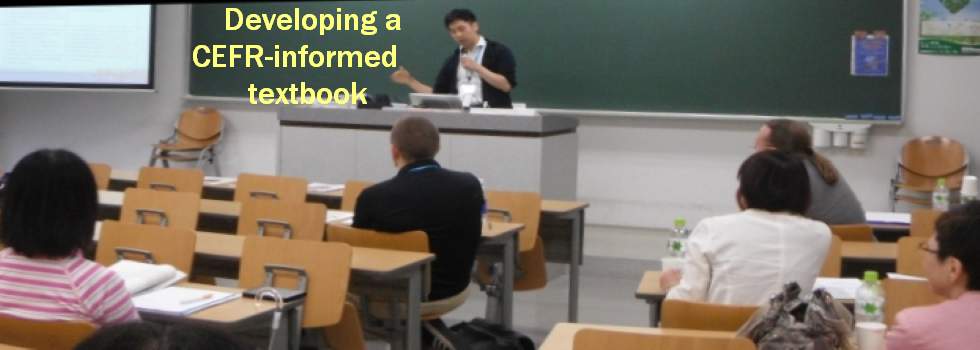The JALT 2009 FLP SIG Forum in Shizuoka featured presenters from universities around Japan outlining issues and practices regarding use of the CEFR and ELP. A recurring theme was that educators are not fully aware of how to use these resources, particularly can do statements, effectively in classes. A short summary of the presentations are found below, the presenters have submitted a more detailed abstract to the conference proceedings
Can do Lists in the Ibaraki University Integrated English Program, by Noriko Nagai
This paper dealt with the development of can do lists for the Integrated English Program- a university-wide general education program in Ibaraki University. She concluded that the details in can do lists will vary depending on the final outcomes being targeted. However, by having shared can do lists based on CEFR, all teachers will have a common ground upon which to discuss the English curriculum and negotiate curriculum development with others. It is ideal to develop a university-wide English program like IEP. However, because such curriculum development involves negotiations with different types of people in an institution, such as top administrators, curriculum committee members, and teachers of English, it is not easily carried out. One person alone (whether administrator, teacher, or committee chair) cannot achieve a fully developed curriculum. However, if one teacher designs his/her own class using can do lists based on CEFR, that effort will constitute part of a wider curriculum development inside and outside a university. One of the greatest merits of using can do lists as tools for class design and for achieving specific outcomes is the model they provides for future collaborative work in developing a coherent English curriculum.
Using the CEFR and portfolio in university classes: A case study in progress, by Yoko Sato
This paper reported on an ongoing case study of the introduction of the CEFR and the ELP in Japanese university English classes. The aim was to explore 1) if and to what extent these contribute to the development of reflective learning in an EFL context where class hours are extremely limited and 2) what instructional approach can be adopted to enhance the effectiveness of these tools when used with students with low self-awareness and different levels of English proficiency.
Most learners found these tools useful and reported positive impacts on learning. They typically felt that these helped them to identify their own strengths and weaknesses, and this in turn enabled them to set clear learning goals and study plans. In particular, the task-specific checklists were crucial in that they allowed the students, many of whom stayed at A1-A2 levels throughout the semester, to see their own progress within these levels, and this in turn led to increased motivation. Video-recording was also found extremely useful by most students because it enabled them to evaluate their own performance more objectively and to notice the inaccuracy of their previous self-perception.
The provisional conclusion emerging from the above is that the combined use of the CEFR grid and task-specific checklists could enhance Japanese university EFL learners’ self-awareness, reflective learning and motivation, if these tools are adjusted to particular classes and student groups, and if regular learner training is provided.
The Implementation of a Japanese version of the “European Language Portfolio—Junior version” in Keio: implications from the perspective of organizational and educational anthropology by Satoshi Atobe, Sachiko Horiguchi and Yuki Imoto
In April 2006, a five-year research project was launched at the Keio Research Center for Foreign Language Education, jointly financed by the MEXT and Keio itself. The research project, as its name ‘Action Oriented Plurilingual Learning Project’ (hereafter the AOP project) suggests, places its aims on promoting an ‘action-oriented’, ‘autonomous’ learning environment of multiple foreign languages. It also aims to promote the continuity and transparency of foreign language education at all levels of the Keio educational system—which consists of one elementary school, three junior high schools, five senior high schools, and ten university departments—and to achieve collaboration among its language teachers. In order to achieve these goals, the AOP project proposes to develop a learning and assessment framework based on the CEFR and adapted for the Keio context. One of the central, ongoing research initiatives within the AOP project has thus been the development of a Japanese version of the ELP to be distributed to language teachers in the various Keio schools.
The enquiry has revealed that whilst tools such as the ELP and CEFR have a potential of answering to teachers’ concern for educational linkage, clear and specific models that are localized to the cultural context of classroom use needs to be devised. At the same time, any policy or framework needs to be left ambiguous and flexible to account for teachers’ orientations and hence their autonomy. The development of a Japanese version of the ELP for Keio would hence involve negotiating a balance between ambiguity in terms of its implementation (or ‘method’) and specificity in terms of its available content.
Senior high school students use of the ELP, by Naoyuki Naganuma, Tokyo University of Foreign Studies
Can do statements (CDS) are becoming widely used by teachers or organizations in their language classrooms or language programs at various university and senior high schools. Can do statements function as goals of achievement for the individual learners and/or evaluation criteria of their language development. This paper will demonstrate a current attempt to utilize different types of can do statements, including the ones in the ELP, at a former SELHi (Super English Language High Schools) school, Kasumigaoka senior high school..
Can do tasks are developed as supplementary tasks used in the classroom to fill in the gaps of language development found through the triangulation of can do statements described above. The can do tasks function as learning tasks as well as evaluation tasks, which confirm whether learners’ have achieved the skills described in the can do statements. Currently additional can do evaluation-learning tasks are under development. They are expected to be connected to each other systematically and construct a module syllabus to support the classroom learning.
The Language Portfolio for Japanese University and future developments, by Fergus O’Dwyer
This paper briefly introduced the Language Portfolio for Japanese University (LP), discusses how it can be improved and describes how it used to efficiently implement use of can do statements in the classroom.
The current version of the LP is a template version; improvements and related developments will be implemented in time. Some of these include work from a proofreading team to check and improve initial Japanese translations, a team to complete all checklist translations (currently available only from lover levels of A1-B1), the LP should be more visual so it would appeal to learners more, and the checklists could be changed to reflect the Japanese context more comprehensively.
The LP and CEFR can facilitate setting and achieving quantifiable and authentic language goals. This can be done by expressing the main aim and content of the learning stage through can do statements, and thereafter formulating a goal for the stage. Rather than merely providing can do statements in the pre-task goal-setting process in insufficient; we need to clearly outline what is involved in relation to a can do statement. Pre-stage reflection should clearly define the important skills associated with the learning stage and incorporating this information into the goal-setting process. Furthermore post-stage reflection can develop learner meta-linguistic knowledge to see how well they can achieve a communicative task and what they need to improve. The use of performance based assessment rubrics links the information in the goal-setting process to provide focused feedback via teacher, peer and self-assessment of the poster presentation. Overall it is felt these pedagogical practices make the learning process quantifiable and learner-friendly in a positive way.
Conclusion and future SIG developments
To sum up the forum papers it is hoped that the practices and in particular specification of the components of can do statements outlined here can achieve the vision outlined by Little (2009), that is the ELP (and by implication the CEFR and can do statements) can help make visible the process and content of L2 learning that is shaped by the principles of learner involvement, learner reflection and target language use. It is fair to say that there is a large focus on standardized testing in Japan with long-standing concerns about the distortion of the curriculum to accommodate such high-stakes testing. Research does not support the view that this can be relied on alone to raise standards while contextualized formative assessment has been shown to improve learning. Falsgraf (2009) goes on to promote tools that put assessment information in the hands of the learners themselves as an important first step in placing value on language proficiency and in helping the wider society interpret and understand that value. It is important to be aware that these pedagogic tools and can do statements must be adapted and changed to suit the specific context they serve. The above issues were the to fore in the discussion at the SIG AGM where the main focus was the related idea of creating a volume of papers, tentatively titled “Can dos in language education in Japan”, which will outline how practitioners have used can do statements in classes to give specific ideas and resources for educators to bring into classrooms. See the call for papers to the left. We hope you will consider submitting an abstract for this publication.
References
Falsgraf, C. (2009) The ecology of assessment. Language Teaching, 42(4), 491-503
Little, D. (2009). Language learner autonomy and the European Language Portfolio: Two L2 English examples. Language Teaching, 42(2), 222-233



